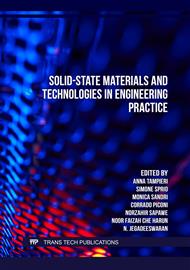p.33
p.47
p.55
p.63
p.71
p.83
p.89
p.101
p.107
Mechanical and Tribological Properties Correlations of Die Cast and Spray Formed Aluminum 2.5wt.% Cu-2.5wt.% Mg - 5wt.% Zn Alloy
Abstract:
Aluminum with –2.5wt.% Cu–2.5wt.% Mg – 5wt.% Zn alloy was synthesized by die cast and spray formed technique. The average density of die cast and spray formed Al alloy was measured by water displacement method. The compression strength, hardness and tribological properties of the Al alloy produced by die cast and spray formed technique was studied as per the ASTM test standards and recorded the average values. The surface morphology of die cast Al alloy depicts the dendritic structures and spray formed Al alloy contains the equiaxed grains, coarse grains and fine grains across the surface. The elemental analysis of both die cast and spray formed Al alloy was measured by using scanning electron microscope. Average percentage of porosity of die cast and spray formed aluminum alloy is 1.79 ± 0.23 and 1.10 ± 0.3 respectively. The hardness of spray formed Al alloy is 10.54 % lesser than that of die cast Al alloy. Average ultimate compression strength of spray formed and die cast Al alloys are 360.07 ± 9.58 MPa and 353.33 ± 5.56 MPa respectively. The study also recorded the wear rate and coefficient of friction of die cast and spray formed Al alloy at different load and speed conditions. The precipitation strengthening mechanism is found to be involved in spray formed alloy.
Info:
Periodical:
Pages:
71-81
Citation:
Online since:
December 2022
Keywords:
Price:
Сopyright:
© 2022 Trans Tech Publications Ltd. All Rights Reserved
Share:
Citation:



